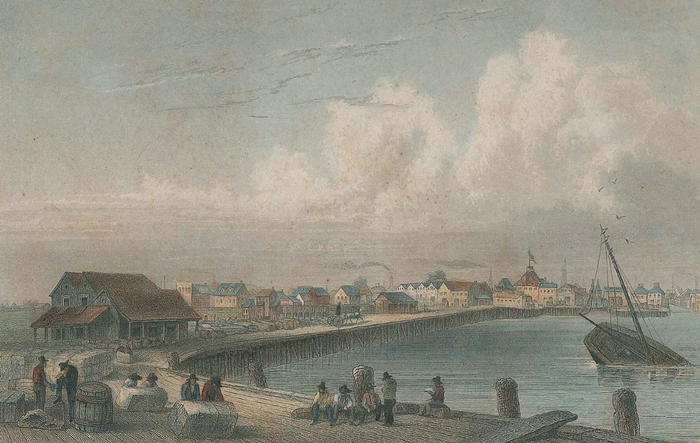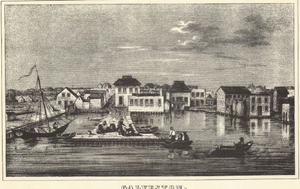The establishment of Galveston
as a port in the early days of Texas was
inevitable given its geography, but around the same time several other inlets
along the Texas coast like Sabine Pass
and Matagorda were also set up as outposts and centers of trade with seemingly
as much potential as the island city. Nevertheless, Galveston claimed priority on an
ever-expanding list of shippers, merchants, and growers throughout the state
and beyond.
The
harbor was untouchable in the natural facilities it provided, but otherwise the
island was rather deficient in agriculture or industry. This meant that
commerce was Galveston’s
only path to prominence, and it was relentlessly pursued by some of the
brightest entrepreneurial minds in the country at the time, who found in the
island city a lucrative outlet for their endeavors. The Strand
is where their fortunes were made, and where their legacies remain.
 Already replete with an array of wooden commercial buildings, the Strand and its neighboring wharf saw a marked growth
within just the first few years of the 1850s, as observed by an impartial
visitor. Having visited the port only once before, a Mr. Bartlett remarked in
his journal on January 9, 1953 that the city “had greatly increased since
August, 1850, when we stopped here. Its commerce, too, judging from the number
of ships and steamers, must have augmented in proportion.”
Already replete with an array of wooden commercial buildings, the Strand and its neighboring wharf saw a marked growth
within just the first few years of the 1850s, as observed by an impartial
visitor. Having visited the port only once before, a Mr. Bartlett remarked in
his journal on January 9, 1953 that the city “had greatly increased since
August, 1850, when we stopped here. Its commerce, too, judging from the number
of ships and steamers, must have augmented in proportion.”
One notable investor in the city’s early commerce was Robert Mills, who
owned several large cotton plantations and was considered by many the richest
man in Texas.
By the time he set up Mills & Company of Galveston
as the primary exporter of his Texas harvests,
he was already a member of other wholesaling firms in New
York and New Orleans.
Paper money had yet to be regarded as legal currency in Texas, but that did not prevent an estimated
$300,000 in paper notes called “Mills money,” solidly backed by Mills’ firm,
from making its way all over the south.
Another of the city’s first prominent businessmen was J.C. Kuhn, who
held a variety of real estate interests including the construction of several
brick buildings on the Strand later in the
decade. He was also the proprietor of Kuhn’s Wharf, one of the first
established wharfs along the harbor that together managed the flow of
commercial vessels on and off the island. Initially, the Galveston City Company
had placed the waterfront properties in the hands of various shipping companies
and warehouse owners, but in 1854 all of that changed.
On February 4th a group of businessmen officially received a
charter for the Galveston
Wharf and Cotton Press
Company and within six short years the affiliation would acquire seven of the
ten operating wharves along the harbor. Their purpose was to maintain and
upgrade the port facilities, establish uniform services for employees, and set
the service fees.
 But
perhaps the duty taken most seriously by the company was the attraction of new
business and exports. Tenacious in their pursuits, the Galveston Wharf
Company’s insatiable desire to secure lines of trade from as far away as the
Midwest and California would eventually earn Galveston the unsavory
nickname, “The Octopus of the Gulf.”
But
perhaps the duty taken most seriously by the company was the attraction of new
business and exports. Tenacious in their pursuits, the Galveston Wharf
Company’s insatiable desire to secure lines of trade from as far away as the
Midwest and California would eventually earn Galveston the unsavory
nickname, “The Octopus of the Gulf.”
1854 also marked the arrival of business partners Henry Hutchings and
John Sealy, two of Galveston’s
most enduring names. The pair had operated a thriving insurance business
together since 1837, but once on the island they turned their interests to
banking after combining forces with George Ball.
In
1857, the first Ball, Hutchings, and Sealy building was erected on the
northeast corner of 24th and Strand; its eventual replacement still
stands today, making it the first of only two buildings to ever occupy the
site.
The year prior a man by the name of E.B. Nichols made his way to Galveston. Soon after, he
would become one of the pioneering merchants of the Strand
as well as another lasting namesake. His firm, E.B. Nichols & Co.,
contributed extensively to the cotton trading business as the agents of several
shipping lines between Boston, New York, and Galveston, and he eventually went
on to serve as president of the Galveston Wharf Company.
Nichols’
first office was in a wood-framed building on the southeast corner 20th
and Strand. A few years later, after Nichols
relocated one block west, the building became a waterfront boarding house
called the Union Hotel. His second location, just east of 21st Street on the south side
of the Strand, was one of J.C. Kuhn’s brick
buildings which Nichols purchased in 1861. Known today as the Nichols Building,
it is one of only three buildings to survive from this decade.
The other two structures still standing were both constructed between
1858 and 1859. The original E.S. Wood Building still sits on the south side of
the Strand between 22nd and 23rd, although it is
unrecognizable today because of its incorporation into Old Galveston Square
during a 20th century restoration. Appropriately, the space that was
the E.S. Wood building is currently occupied by Galveston Historical
Foundation’s 1891 bookstore. The other is Hendley Row, considered the oldest
building on the Strand today.
The wholesale firm of Hendley & Co., led by brothers Joseph and
William Hendley, John L. Sleight, and Noah N. John, was one of the first in
Galveston and originally occupied a two-story wooden structure on the Strand.
Hendley Row was constructed on the adjacent block to the east of this first
location, between 20th and 21st Streets, in partnership
with Thomas M. League and a Mr. Guilbonu. The elder Hendley brother William
supervised the construction from granite, brick, cement, and lime that was
shipped to Galveston from the north.
Actually
four separate, three-story buildings with a façade that makes them appear as
one, Hendley Row was the largest commercial structure in the state of Texas
when it was completed in 1859.
By the end of the decade, Galveston’s population had swelled to over
nine thousand and the port was exporting nearly 150,000 bales of cotton per
year to both European and domestic ports, all of which was compressed in
Galveston. Gross exports and imports for the 1859-1860 season surpassed over
$15 million, which meant that the largest city in the state also had the
wealthiest population, many of whom boasted associates and interests in Europe,
the Indies, Mexico, England, Havana, New Orleans, and even cities all over the
east coast including New York.
Merchants, bankers, shippers, transportation enterprises, politicians,
newspaper publishers, and attorneys composed an upper echelon of Galveston
society that was lavish in both their expenditures and philanthropies, also
aided by generous tax relief. “Probably in proportion to its population, in
1860 there was no more prosperous community in the United States than that of
Galveston” (Galveston Daily News, 26
March 1911).
This prosperity assisted Galveston in reaching its goal of being a
permanent destination on the routes of many well-established transit lines like
the Morgan Star Line and Mallory Line, and Galveston was also the beneficiary
of fast-advancing technologies that made marine transportation incredibly more
efficient. But the crown in its watery cap came in 1859 with approval of bonds
for the construction of a $100,000 rail bridge that would link the island to
the mainland and bring the railroad to Galveston for the very first time.
Completed in January of 1860, the development of the Galveston, Houston,
and Henderson Railroad was an enormous asset to a city that was already
thriving despite the odds wagered by its isolation from the interior. Thus it
was wholeheartedly supported and promoted by both residents of Galveston and
the elite businessmen, as the growth of the city was inextricably linked to the
success of its commercial pursuits.
The
first GHHR Board of Directors was practically a directory to the 1850s Strand,
including names such as E.B. Nichols, J.C. Kuhn, Thomas M. League, and George
Ball. The connection of Galveston to the rest of the country via rail opened up
endless possibilities and visions of a bountiful new decade, but soon the
resolve of Galveston, the longevity of the Strand, and the strength of a nation
were all about to endure the ultimate examination.
Chapter 1 - 2 - 3 - 4 - 5 - 6 - 7- 8 - 9 - 10 -11 - 12